| 10-10-06 - DREAM - I woke up from this dream feeling really disgusted,
not knowing that it had a great meaning, which was revealed to me by a
friend an hour later.
In the dream, I was in New Berlin, WI. I went for a walk outside the
house and discovered that someone had made a tunnel into the hill behind
the house. I needed to investigate the tunnel so I would know what was
going on, because this tunnel looked like it was under my house.
I walked into the tunnel, and it appeared to be a garage of some kind
where there were old vehicles needing repair. A moment later I saw a
workman, dressed in an orange-red coveralls. I didn't want to be
confronted by the man, so I ran up some metal-like stairs to the next
level up and ran down a long hallway.
I found myself in a large room with some very strange people and
creatures. There were naked people in the room, one woman was laying
on a lounge-type couch with a blanket only over her feet. I
recognized her and called her Barbara. She had dark, very curly hair -
like the Greeks are shown in paintings.
Over further, I saw a creature which looked part goat-part cow, with 4
udders up by his neck. I don't recall seeing his hands - many of the
people's arms ended in skinny stumps with no hands.
Then a woman came up to me, she was tall and beautiful. Then a huge
swan came up to her and she bent to kiss it on the beak. Suddenly, the
swan dipped his whole head into her mouth and pulled out her heart and
swallowed it.
I expected the woman to die instantly, but she didn't. She said, "He
took my heart!" and I saw the swan swallow her heart like a snake swallows
its prey. She went over aways a lay down with a smile on her face
like she was in love and leaned against a man figure laying down on a
pallet on the floor.
I knew I had to leave this place, so I walked past Barbara, and rubbed
her short hair and told her, "Barbara, I love you."
I left the room as quickly as I could, but by the stairway were two
midgets. Neither one had hands either - their arms ended in skinny stumps.
One midget had a huge square head. The other one had a huge round head.
I couldn't see their faces as they were turned away from me. I just wanted
to get out of there and ran down the stairs and out the tunnel.
NOTE: I didn't want to write this weird dream down because it felt so
disgusting in my mind, but the phone rang and we told each other our
dreams. My friend said, "You were dreaming mythology. I just saw a
picture of that in DaVinci's book of paintings. That is Leda and the Swan.
There is symbolism in the paintings of the time. People back then
knew how to read paintings - every one told a story."
Michelangelo and Da Vinci had a running competition to out do each other at
the time. The story of Leda and the Swan is a Greek myth which is
told in various versions. Leda, the wife of the king of Sparta, was loved
by the god Zeus. He transformed himself into a swan and came to lie
with her. As a consequence of their union she bore the twins Castor and Pollux, who were hatched from eggs. The subject was popular during the
Renaissance. Zeus was the supreme ruler of all the gods and
mortals. He is also known to the Romans as Jupiter. His powers enabled him to
change into the shape of anything he wanted, which he often did in order
to mix with mortals on earth. He also used these transformations to hide
from his wife, Juno, while he was pursuing beautiful women. Zeus/Jupiter may
appear in paintings disguised as a swan, a bull, an eagle, a cloud or a
shower of gold. The stories are from the 'Metamorphoses', a long poem by
the Classical (Roman) poet Ovid. NOTE:
The name "Barbara" is of Greek and Latin origin, basically
meaning "foreign woman." It was a common name in Scotland. The Gaelic form
is "Barabell" (BA-ra-bul). The Scots-Gaelic form is "Barabal." The Irish
-Gaelic form is "Báirbre" (BAR-bruh) and the pet form "Baibín" (BAB-een).
|
Leda
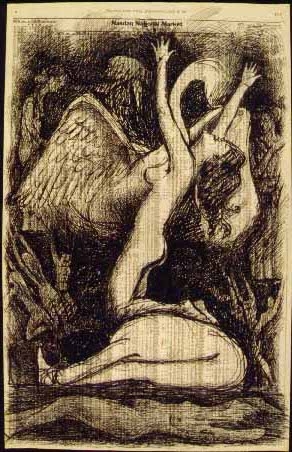
Zeus is the ruler of the Olympian gods. He is also known as Jupiter and
Jove (both Roman). His attributes in iconography include the lightning bolt,
the eagle, and the sceptre.
Zeus,
King of the Gods, uses his magical powers to transform himself into other forms
(here, a swan) to seduce (in this case) Leda, much as traders & investors
transform themselves into millionaires through the magic of the stock market and
seduce countless people. I imagine Leda embracing the swan upon the back of her
husband, King Tyndareus of Sparta, who despairs at her infidelity. Beneath him
is his own hidden mistress or perhaps his anima. A chorus of figures emerge from
the shadows -- they are trying to reach the mighty Zeus, or perhaps they are
spurned lovers, victims of greed & misused power.
LEDA
by Jamie Cisco
Leda was the daughter of Thestius and the wife of
Tyndareus. She has been known as the Queen of Sparta.
Leda was seduced by
Zeus
when he came to her in the form of a swan. Leda gave birth
to an egg. From it hatched the
Dioscuri, the twins Castor and Pollux. With Zeus she
also had
Helen and with Tyndareus she had
Clytemnestra.
Clytemnestra was the wife of
Agamemnon, king of Mycenae. She was one of the tragic
women in the Trojan War. While Agamemnon was away in the
war, Clytemnestra took
Aegisthus as her lover, and together they plotted to
kill Agamemnon when he returned. One of her reasons was her
husband's sacrifice of their daughter. When Agamemnon
returned Clytemnestra pretended to greet him. Later, while
Agamemnon bathed, Clytemnestra murdered him. She, herself
was killed by her son
Orestes.
Helen of Troy was said to be the most beautiful woman
in Greece and the major cause of the Trojan War. While still
a young girl, Helen was carried off by an Athenian hero,
Theseus. Before any harm could come to her the Dioscuri
rescued her. Later, she was sought after by almost every
prince in Greece, but she finally married
Menelaus, king of Sparta, who was the richest of the
suitors. Helen and Memelaus had one child. Her name was
Hermione.
Helen and Menelaus' marriage was threatened when
Paris, a Trojan prince, fell madly in love with Helen.
Taking advantage of Menelaus' absence from the palace, Paris
abducted Helen and then left for Troy. This was the cause of
the Trojan War. All of the other prices had promised
Tyndareus, Helen's father, that he would in case of need,
come to the aid of the lucky man who became Helen's husband.
Faithful to their oaths, all the princes of Greece took
power under the command of Agamemnon to avenge the outrage
done to Menelaus.
For ten years the battle raged before the walls of
Troy. Finally the Greek warriors were able to enter the city
by hiding in the hollow flanks of a large wooden horse (see:
Trojan horse) which the Trojans themselves had put in
the city. Troy was conquered and set on fire. Helen was
returned to Menelaus and they were reconciled. After
Menelaus' death, Helen was put among the stars with Dioscuri.
Castor and Pollux had a magnificent temple erected in
their honor. They accompanied the Roman army on its
campaigns and during battles were seen among the cavalry.
They also protected sailors and travelers at sea. At Ostia
they calmed a storm which was not allowing ships loaded with
corn from entering port. Castor and Pollux carried off the
two daughters of Leucippus and married them. This was the
reason for their quarrel between Idas and
Lynceus, who were also seeing the two young women.
Pollux killed Lynceus while Castor was mortally wounded by
Idas. Pollux wept over the body of his brother; for being
himself immortal he could not follow Castor to the Kingdom
of Hades.
"In their quality of marine god they naturally
presided over commerce." In the second century CE they were
incorporated in funeral rituals and their popularity was so
great that even Christians did not deny that they were
symbols of life and death.
From:
http://www.pantheon.org/articles/l/leda.html
This page has a small version of Francois
Boucher's painting - seen in large size below.
|
|
David, Michelangelo - 1504
Michelangelo, born, Michelangelo Buonarroti
(b. March 6, 1475, Caprese, in Tuscany,
Republic of Florence [Italy]--d. Feb. 18, 1564, Rome),
Perhaps the greatest influence on western art in the last
five centuries, Michelangelo was an Italian sculptor,
architect, painter and poet in the period known as the High
Renaissance. His great works were almost entirely in the
service of the Catholic Church, and include a huge statue of
the Biblical hero David (over 14 feet tall) in Florence,
sculpted between 1501 and 1504, and the ceiling of the Sistine
Chapel in Rome.
The second of five brothers, he was
one of the most inspired creators in the history of art and,
with Leonardo da Vinci, the most potent force in the Italian
High Renaissance.
|
The
Life, Work and Secret of Leonardo Da Vinci
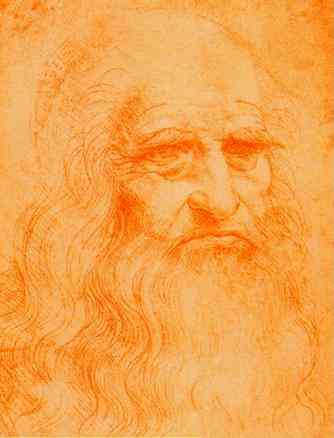
Leonardo da Vinci. Self-Portrait.
1512. Red chalk on paper. Biblioteka Reale, Turin, Italy
Leonardo
da Vinci (Vinci, Italy, April 15, 1452 ? May 2, 1519, Cloux,
France) was an Italian Renaissance polymath: an architect,
musician, anatomist, inventor, engineer, sculptor, geometer,
and painter. He has been described as the archetype of the
"Renaissance man" and as a universal genius, a man infinitely
curious and infinitely inventive. He is also considered one of
the greatest painters that ever lived.
In his lifetime, Leonardo his surname is unknown, "da Vinci"
means "from Vinci" was an engineer, artist, anatomist,
physiologist and much more. His full birth name was "Leonardo di ser Piero da Vinci", meaning "Leonardo, of ser Piero from
Vinci". Leonardo is famous for his paintings, such as the Mona
Lisa and The Last Supper, as well as for influential drawings
such as the Vitruvian Man. He designed many inventions that
anticipated modern technology, such as the helicopter, tank,
use of solar power, the calculator, etc., though few of these
designs were constructed or were feasible in his lifetime. In
addition, he advanced the study of anatomy, astronomy, and
civil engineering. Of his works, only a few paintings survive,
together with his notebooks (scattered among various
collections) containing drawings, scientific diagrams and
notes
It was the period of the renaissance when Leonardo da Vinci
was born on 15. April 1452. Leonardo was born probably in this
farmhouse in Anchiano, which is 3 km away from Vinci. The
family of Leonardo lived in this area since the 13th
century. The father of Leonardo da Vinci, Ser Piero, was a 25
years old public notary when Leonardo was born. In the same
year when Leonardo was born Ser Piero married his first wife.
He didn't marry the mother of Leonardo, because probably she
was a daughter of a farmer. The mother of Leonardo was called
Catarina. Her first name is all what we know today.
His original of Leda and the Swan did not
survive. It is known only through copies.
Excerpted from:
http://www.leonardodavincisecrets.com/gallery.html |
Leda and the Swan
From Wikipedia, the free encyclopedia

Leda and the Swan: copy after a lost
original by
Michelangelo, one of the iconic images of
16th century
Mannerism
The
motif of Leda and the Swan from
Greek mythology, in which the
Greek god
Zeus came to
Leda in the form of a
swan, was rarely seen in
Gothic art, but resurfaced as a classicizing
theme, with
erotic overtones, in Italian painting and
sculpture of the 16th Century. The most familiar
examples are the copies of
Leonardo da Vinci's lost painting, with the two
sets of infant twins, 1508;
Correggio's elaborate composition of c.
1530 (Berlin); and two versions of a lost
Michelangelo (illustration, right) that is
also known from an engraving by
Cornelis de Bos, c. 1563; the marble
sculpture by
Bartolomeo Ammanati in the Bargello, Florence; and
the painting after Michelangelo, c. 1530, in
the National Gallery, London. The Michelangelo
composition is a definitive example of
Mannerism.
Leda and the Swan furnished a common motif for
the rapidly unfolding visual arts into the 19th
century.
"Leda And The Swan" is a poem by
William Butler Yeats first published in
1924. Reviving what had become an insipid
classical cliché by combining psychological realism
with a mystic vision, it describes the swan's mating
with
Leda.
According to later Greek mythology, Leda bore
Helen and
Polydeuces, children of Zeus while at the same
time bearing
Castor and
Clytemnestra, children of her husband
Tyndareus, the King of
Sparta. As the story goes, Zeus took the form of a
swan and slept with Leda on the same night as her
husband, King Tyndareus. In some versions, she laid
two eggs from which the children hatched. In other
versions, Helen is a daughter of
Nemesis, the goddess who personified the disaster
that awaited those suffering from the pride of Hubris.
- A sudden blow: the great wings beating still
- Above the staggering girl, her thighs
caressed
- By the dark webs, her nape caught in his
bill,
- He holds her helpless breast upon his breast.
- How can those terrified vague fingers push
- The feathered glory from her loosening
thighs?
- And how can body, laid in that white rush,
- But feel the strange heart beating where it
lies?
- A shudder in the loins engenders there
- The broken wall, the burning roof and tower[1]
- And Agamemnon dead.
-
-
-
-
- Being so caught up,
- So mastered by the brute blood of the air,
- Did she put on his knowledge with his power
- Before the indifferent beak could let her
drop?
- "Was this the face that launched a thousand
ships/ And burnt the topless towers of Ilium?" (Christopher
Marlowe, Doctor Faustus). Both Helen and
Clytemnestra were Leda's daughters.
|
|
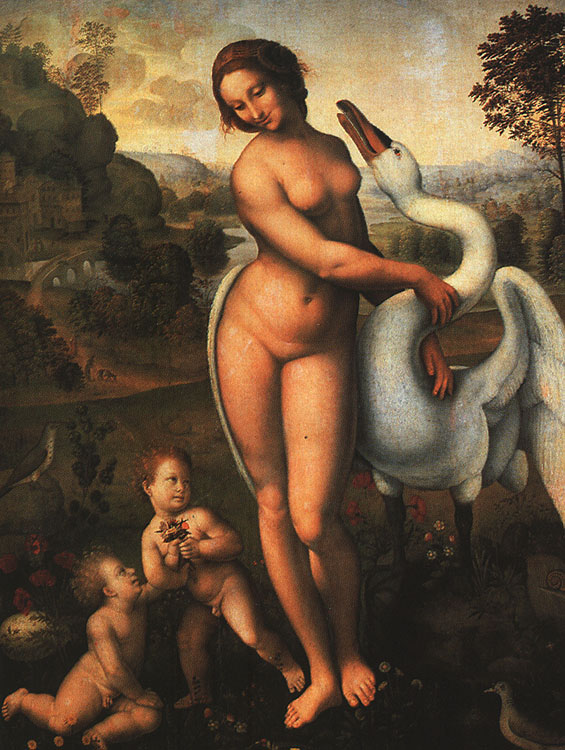
Copy of Da Vinci Painting.
These scene was 'very' similar to the scene in my dream.
The woman and the swan were identical positions from where I
stood
only I was closer to them - very close.
In my dream, she did not turn away, she kissed the swan and he
dipped
his head into her mouth and throat and pulled out her heart
and swallowed it. |
|
Leonardo was very absorbed with the theme of Leda during
the time he was working on Mona Lisa and while in Milan
he made many sketches of the swans in the moat around
the Castello. The picture was described by Cassiano del
Pozzo in 1625; at this stage it was in the royal
collection in Fontainebleau:
"A
standing figure of Leda almost entirely naked, with the
swan at her and two eggs, from whose broken shells come
forth four babies, This work, although somewhat dry in
style, is exquisitely finished, especially in the
woman's breast; and for the rest of the landscape and
the plant life are rendered with the greatest diligence.
Unfortunately the picture is in a bad state because it
is done on three long panels which have split apart and
broken off a certain amount of paint." |
|
By the eighteenth century the
artwork was completely lost to us; fortunately several
things remain to give a good idea what it looked like.
There are Leonardo's drawings of the head and bust of
Leda; a famous drawing done in 1506 by Raphael; a
red chalk drawing which may have been done by an
assistant to Leonardo; a picture by Bugiardini which
was based upon Leonardo's original cartoon (done in
1504); another copy probably by Francesco Melzi and
based on Leonardo's second cartoon (drawn around
1508); plus a copy by another pupil, Cesare da Sesto;
this final work is said to be closest to Leonardo's
original and is displayed on this page. Leonardo's
head and coiffure study for Leda and the Swan
is signed; it should be noted that this is not his
signature, having been added at a later date by one of
the owners.
Of
the two cartoons Leonardo did for this work one showed
Leda kneeling and used mostly curved lines to suggest
aa writhing movement which emphasised fertility; the
other had her in a standing position. In the final
painting Leda was in the second of the two poses and
seeming to recoil from the swan, while at the same
time showing a shy attraction towards it. Leda's head
was modestly lowered giving a virginal look, in
contrast her figure was opulent, a mature body with a
young head on her shoulders. Like many of Leonardo's
subjects her hair was painted in minute detail. She
was surrounded by the most fertile landscape that
Leonardo -- by this time aged 54 -- had produced since
his workshop days. The swan was Jupiter in one of his
many disguises and the babies were Castor and Pollux,
and Helen and Clytemnestra. |
|
|
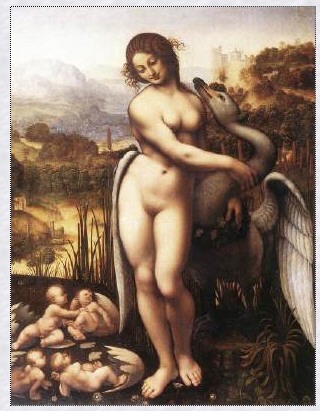
This is a copy by Cesare da Sesto
(1477-1523) after the lost painting by Leonardo da Vinci.
The eye, believed by Leonardo to be the key to everything. He
once
said , "Who would believe that so small a space could contain
the
images of the universe?" It was through his eyes masterpieces
were
conceived and painted.
|
|
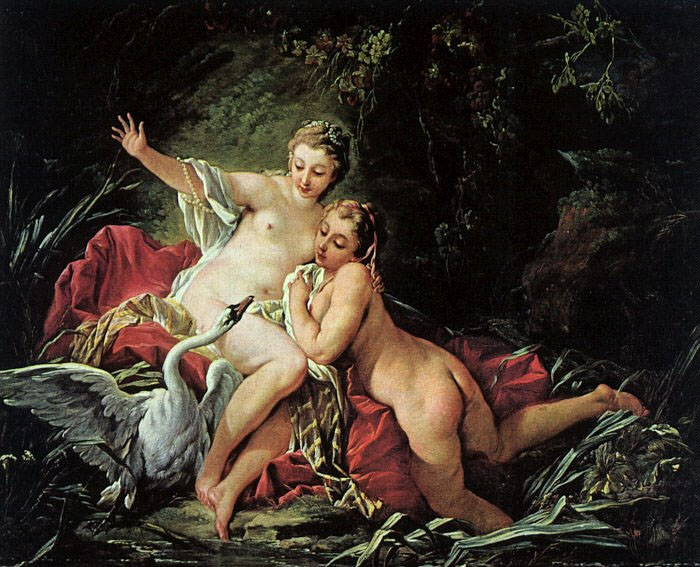
Francis Boucher
France - 1741
|
FRANÇOIS BOUCHER
Paris 1703 - 1770 Paris.
The extraordinary career of
Francois Boucher was unmatched by his contemporaries in
versatility, consistency and output. For many,
particularly the writers and collectors who led the
revival of interest in the French rococo during the last
century, his sensuous beauties, coquettish milkmaids and
plump cupids represent the French eighteenth century at
its most typical. His facility with the brush, even when
betraying the occasional superficiality of his art,
enabled him to master every aspect of painting - history
and mythology, portraiture, landscape, ordinary life and,
as part of larger compositions, even still life.
He had been trained as an engraver, and the skills of a
draftsman which he imbued in the studio of Jean-Francois
Cars stood him in good stead throughout his career; his
delightful drawings are one of the most sought after
aspects of his oeuvre. As a student of Francois Le Moyne
he mastered the art of composition - although in later
years he was to deny his debt to Le Moyne - while the four
years he spent in Italy, from 1727-1731, gave him the
education in the works of the masters, in the classics and
in history, that his modest upbringing had denied him.
On his return to Paris, in 1734, he gained full membership
of the Royal Academy of Painting and Sculpture with his
splendid Rinaldo and Armida (Paris, Musee de Louvre), a
bold rococo statement which, while showing his awareness
of the famous composition of Domenichino in the French
Royal Collection, is marked nonetheless with the very
distinct characteristics of his own, maturing style.
Although he occasionally painted subjects taken from the
Bible throughout his career, and would always have first
considered himself to be a history painter, his own
repertoire of heroines, seductresses, flirtatious peasant
girls and erotic beauties was better suited to a lighter,
more decorative subject matter.
| His mastery of technique and
composition enabled him to move from large scale
tapestry cartoons (he worked throughout his career
for both the Beauvais and Gobelins tapestry
factories, becoming director of the latter in
1755), to intimate masterpieces such as the Diana
Resting (Paris, Louvre) or Leda and the Swan (ex
Stair Sainty Matthiesen, New York and now Los
Angeles, Private Collection) and the occasional
scene from everyday life such as The Luncheon
(Paris, Louvre), with its elegantly dressed
figures grouped around a well-laid table.
|
Enormously successful and widely
patronized, Boucher's output was prodigious. First
patronized by the Crown in the 1730s, he executed
numerous royal and princely commissions until his
death in 1770, working particularly for Louis XV's
mistress, the Marquise de Pompadour in each of her
several palaces. Always ready to utilize his talents
in other fields, he designed stage sets for theatre
and opera and provided drawings to be used as designs
for figures at the Vincennes (later Sevres) porcelain
factory.
As a teacher he was much loved by his many
students, who included Fragonard, Le Prince, Deshays,
Brenet, Baudouin, Lagrenee, and Madame de Pompadour
herself. Even David, a distant cousin, in his earliest
surviving works with their colourful rococo palette,
was clearly influenced by Boucher. Not since Le Brun
had a single French artist held such a monopoly on the
imagery of a particular society or left such a mark on
the arts of his time. |
|
|
|
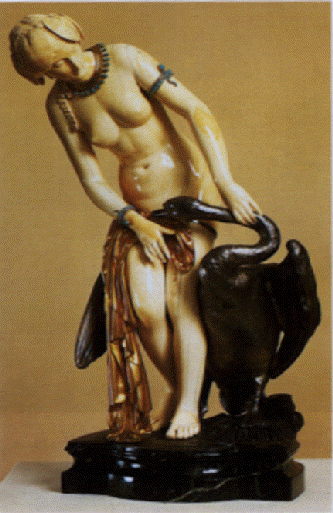
Pradier,
James. Leda (c. 1850)
Here, Leda is again
unclothed and the swan is sculpted in a very sexual position.
Leda does not appear concerned and has her hand on the swan's
neck, caressing it. Despite the lack of clothing, the jewelry
and arm band are done in Greek style
|
|
|
|
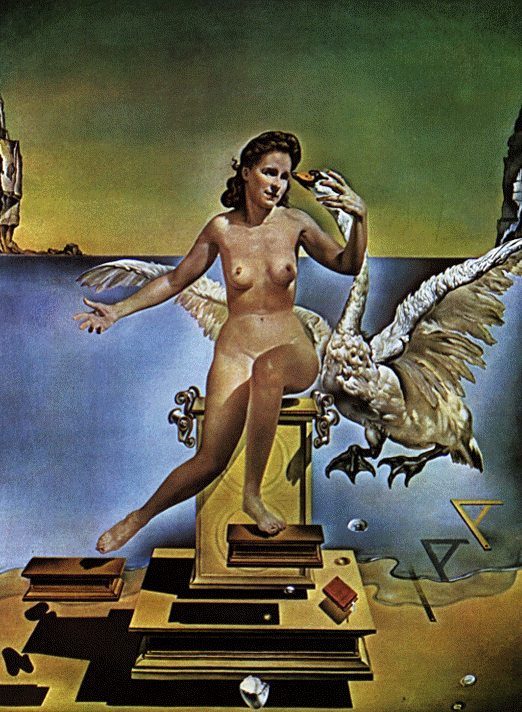
Dali,
Salvador. Leda atomica (1949)
The most recent
painting, or work for that matter, on this site. Books and
silver bubbles are floating around, plus Leda is on a
pedestal, which are all objects added by the artist, as these
have nothing to do with the Greek myth. Four hundred years
after Leonardo da Vinci's work, the scene is still the same.
Leda is caressing the swan, looks happy and is not dressed.
Some things never change.
In 1939,
Salvador Dalí designed the set and wrote the
libretto for a ballet entitled Bacchanale,
based on Wagner’s Tannhaüser and the myth of Leda and
the Swan.
Symbolism
Dalí employed extensive symbolism
in his work. For instance, the hallmark soft watches
that first appear in The Persistence of Memory
suggest
Einstein's theory that time is relative and not
fixed.The idea for clocks functioning symbolically in
this way came to Dalí when he was staring at a runny
piece of
Camembert cheese during a hot day in August.
The elephant is also a recurring
image in Dalí's works, appearing first and very
prominently in his 1946 work The Temptation of St.
Anthony. The elephants, inspired by Gian Lorenzo
Bernini's sculpture in Rome of an elephant carrying an
obelisk, are portrayed "with long, multi-jointed,
almost invisible legs of desire" along with obelisks
on their backs. Coupled with the image of their
brittle legs, these encumbrances, noted for their
phallic overtones, create a sense of weightlessness.
"The elephant is a distortion in space," one analysis
explains, "its spindly legs contrasting the idea of
weightlessness with structure."
The egg is another common
Daliesque image. He connects the egg to the prenatal
and intrauterine, thus using it to symbolize hope and
love[34];
it appears in
The Great Masturbator and
The Metamorphosis of Narcissus. Various
animals appear throughout his work as well: ants point
to death, decay, and immense sexual desire; the snail
is connected to the human head (he saw a snail on a
bicycle outside Freud’s house when he first met
Sigmund Freud); and locusts are a symbol of waste
and fear.
His fascination with ants has a
strange explanation. When Dali was a young boy he had
a pet bat. One day he discovered his bat dead, covered
in ants. He thus developed a fascination and fear of
ants.
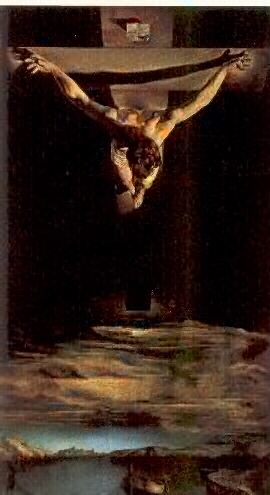
|
CHRIST OF ST. JOHN OF THE CROSS
by Salvador Dali
1951 |
See:
http://www.greatdreams.com/bison.htm
|
|
Typical Leonardesque symbolism such as wild primrose, which
represents resurrection, and the blue veronica flower, symbol
of the eyes of the Virgin Mary.
In the Last Supper, the
disciple to the left of Jesus pointing his finger towards the
ceiling gives a clear indication that the mystery in this
painting is hidden there
"There is a Holy Grail in the
painting completed through the image of Jesus. If you
interpret the painting in the light of mathematical
precision, circular study and symbolism (the pointing
finger) that Da Vinci uses, the disciple to the left
of Jesus pointing his finger towards the ceiling gives
a clear indication that the mystery in this painting
is hidden there. Considering why the artiste left
almost half the area of the painting to depict
ceilings and doors," says Antony. A look at his
interpretation explains it all. The 12 beams on the
ceiling indication twelve levels of wine in a grail
that can be extrapolated using the technique of mirror
image above the figure of Jesus. A case of disguised
symbolism, explains Antony. Similarly Francis uses the
Vitruvian Man and circular study to indicate the
presence of Holy Bread in the painting.
On the controversy about the
presence of Mary Magdalene in the painting, "It can be
seen that the figure is taller than Jesus. Da Vinci
would not have made a mistake of drawing a woman
figure of greater height that Jesus," he says.
Incidentally Francis embarked on a series De coding
Da Vinci by tracing back The Last Supper
step by step through under paintings.
|
|
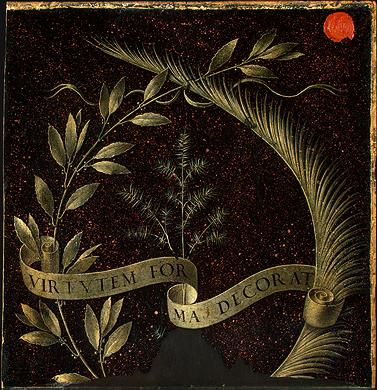 Leonardo
da Vinci, Ginevra de' Benci
(reverse), c. 1474/1478, oil on panel, National
Gallery of Art, Ailsa Mellon Bruce Fund Leonardo
da Vinci, Ginevra de' Benci
(reverse), c. 1474/1478, oil on panel, National
Gallery of Art, Ailsa Mellon Bruce Fund
The sprig of juniper in
the center of the wreath represents Ginevra herself. In
Italian, the word for juniper ("ginepro") sounds a lot
like her name. The same plant is featured prominently on
the
other side
of this painting. It is a symbol of purity, while the
laurel and palm represent intellectual and moral virtue.
The Latin inscription "Beauty Adorns Virtue," with the
word for beauty encircling the juniper, also reminds
viewers that Ginevra de' Benci was a beautiful,
intelligent, and virtuous young woman.
He
with a sort of religious sentimentalism, took for his
device the mulberry-tree– the symbol, in its long delay
and sudden yielding of flowers and fruit together, of a
wisdom which economises all forces for an opportunity of
sudden and sure effect.
Da Vinci used his hands
as well as brushes to work on his paintings and left his
fingerprints on his paintings, which people have recently
used to identify him. |
|
|
Leonardo was responsible for the decoration of the
ceiling and vault of the Sala delle Asse
(translation: 'room of the tower' or 'room of the wooden
boards') in Sforza's castle, Milan and although this
cannot be considered a 'painting' in the usual sense of
the word to not mention it would be unforgivable. He was
presented with this room for his own use; access being
gained via a bridge and arcade he had built over the
moat.
Painted between 1495--1497, the fresco is made up of
eighteen willow trees, two of which skillfully encircle
two windows in the room . Where the boughs meet towards
the ceiling they intertwine, thought to be a symbol of
the marriage of Ludovico, Duke of Milan with Beatrice
d'Este. Emblazoned throughout the branches is a
fantastic golden rope made up of assorted loops and
knots. Appearing to be several ropes, if it is followed
the viewer discovers it is actually just the one cord
which folds back on itself, twisting and turning
throughout the entire pattern. Gold rope was a
fashionable symbol of the day and appeared knotted on
the clothing of Beatrice d'Este. Included in the work is
the coat of arms of the Sforza family (falcons and
serpents) which is painted in the very centre of the
ceiling where the tree branches meet. Finally, four
tablets were hung in the corners of the room to record
important historic and political events of the day.
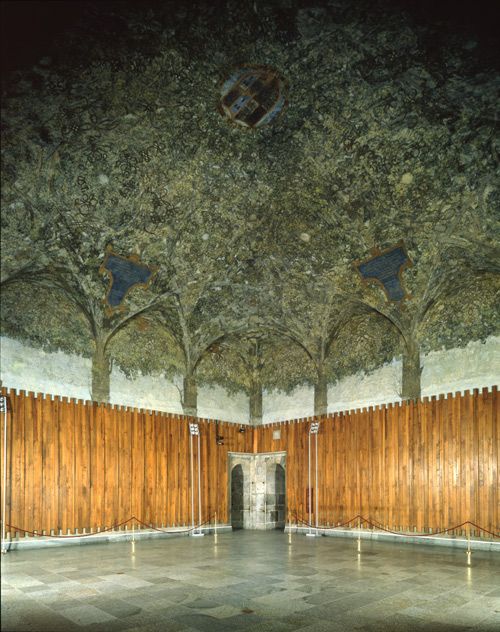
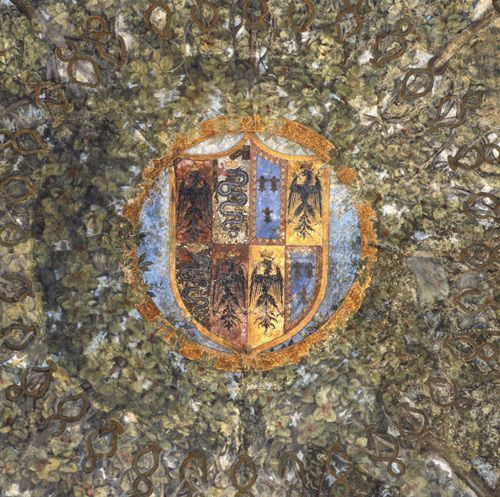
Sala delle Asse
(Detail)
Sforza Castle, Milan
Much
of the work on the 2,880 square foot canopy was carried
out by Leonardo's pupils, but he did the design and this
is a play on the word 'vinci', one meaning of which is
willow. The search for any other hidden significance
among the designs still continues, however it appears
there is none to be found.
The
hall was then used as a barracks and the paint
deteriorated and flaked away. In 1901 a restoration was
begun by Luci Beltrami; just enough of the original
paint remained for this to be successful, but the work
done was so extensive that the fresco was largely remade
and repainted. Beltrami completed the restoration by
taking the few remaining traces of the original and
repeating the designs and motifs until the entire vault
was covered. Like the Last Supper, this is not
the work Leonardo would have originally presented to the
world.
Further restoration went on in 1954 during which time a
thorough cleaning of one small area was done and some
boards removed which had been left untouched during the
previous restoration; this revealed to some extent
exactly how much the fresco had been altered by over
painting. Originally the work was more open between the
trees and branches, with the paint being less heavy, the
leaves and branches more wavy. Large rocks were revealed
through which roots were intertwined rising into huge
tree trunks. Restorers of 1954 restrained themselves
from completely removing all of the reconstruction done
by Beltrami, restricting their own work to removing the
heaviness evident in the new painting. With this they
hoped the scene would achieve a more naturalistic look
something Leonardo would have aimed for.
|
|
|
|









 Leonardo
da Vinci, Ginevra de' Benci
(reverse), c. 1474/1478, oil on panel, National
Gallery of Art, Ailsa Mellon Bruce Fund
Leonardo
da Vinci, Ginevra de' Benci
(reverse), c. 1474/1478, oil on panel, National
Gallery of Art, Ailsa Mellon Bruce Fund
